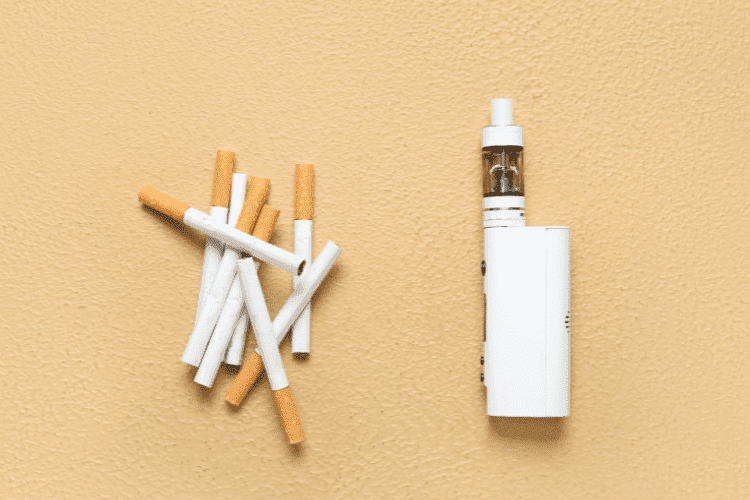A question smokers new to vaping often ask is, "How many cigarettes are in a vape?" This isn't an easy question because the answer varies based on many aspects, such as the vape type, the strength of nicotine, and your usage patterns.
More so, traditional cigarettes deliver nicotine through smoke, while vapes use vapor. The nicotine content and how your body absorbs it can vary greatly between the two.
In this post, we’ll compare nicotine intake from vaping versus smoking cigarettes. We'll discuss different types of vapes and how they stack up against traditional cigarettes.
As you read through, you'll have a stronger understanding of how your vaping habits differ from smoking and how you can make more informed choices on your nicotine use. Let's hit it!
Nicotine Delivery in Vapes and Cigarettes
How much nicotine do cigs and vapes really offer? There's a significant difference in nicotine delivery between standard cigarettes and vape products. Both do provide nicotine, but the way your body absorbs it and how quickly it acts can vary.
Traditional Cigarettes:
- Nicotine Quantity: According to a report by Kuiper et al. from the Centers for Disease Control and Prevention (CDC), one cigarette has approximately 10mg of nicotine.
- Absorption: Your circulatory system absorbs nicotine directly through cigarette smoke. The absorption happens within a short time due to the high temperatures of the smoke.
- Rapid Hit: The rapid absorption allows smokers to receive an immediate hit of nicotine, satisfying their cravings almost instantly.
Vape Devices:
- Nicotine Delivery: Vaping delivers nicotine through vapor instead of smoke. However, expect a slower absorption process because the vapor is cooler than cigarette smoke. Note that vape creators often include the total nicotine content on the label.
- Absorption: How your body absorbs nicotine will differ depending on the device type, the strength of the e-liquid, and your vaping style. There are certain vapes that release a quicker hit of nicotine, while others provide a slow build-up.
- Efficiency: High-concentration nicotine vapes can still provide a fast delivery of nicotine, although it'll be a bit slower than the instant hit of a cigarette.
Generally speaking, nicotine consumption in both cigarette smoking and vaping is different, as well as the rates of delivery and absorption. Depending on the vape, some will deliver nicotine more quickly while others may take longer, leading to different experiences and satisfaction.

Vape Types and Their Cigarette Equivalent
Vapes come in a variety of forms, each differing based on nicotine content and delivery. Here's a breakdown of the different kinds of vapes vs. cigarettes ratio:
Disposable Vapes
You'll find disposables with anywhere from 1% (10mg/ml) to 5% nicotine (50mg/ml).
Cigarette Equivalent
If an average cigarette delivers 10 mg of nicotine, this means one disposable vape equates to 1 to 20-plus packs of cigarettes, depending on the vape's size and how much nicotine is within.
For example, small, low-nicotine disposable vapes (10-20mg/ml) may deliver the nicotine of 1 pack of cigarettes. On the other hand, high-puff count, larger disposable vapes (50mg/ml nicotine and higher vape juice capacity) may contain nicotine worth 10 to 20-plus packs of cigarettes.
Research from the University of California San Francisco (UCSF) notes that today's vapes can easily provide the nicotine content of "three cartons or 600 cigarettes."
- Why?: Due to a higher concentration of nicotine per puff, disposable vapes deliver more nicotine from fewer puffs than a standard cigarette. They're therefore an effective way of quick nicotine delivery.
Note: Blakk Smoke creates nicotine-free hookah vapes that don't contain any tobacco. Unlike traditional vapes, these disposable hookah pens don't equate to any amount of cigarettes. Simply said, these vapes equal zero cigarettes, making them a healthier option for conscious smokers.
Pod Systems
Vape pods often use nic salts that provide a higher concentration, minus the harsh throat hit found in cigs. This means a pod user can comfortably inhale more smoke, resulting in more nicotine intake.
Pod systems contain anywhere between 10mg/ml and 50 mg/ml of nicotine. Since a pack of cigarettes provides about 30-40 mg of absorbed nicotine, one vape pod of 50mg/ml will contain an estimated 35 to 50mg of nicotine, which is about one pack of cigarettes.
- Note: A heavy pod user is able to take in the same amount of nicotine as an average cigarette smoker.
Sub-ohm Vapes
Sub-ohms are high-vapor production devices that smokers use with lower nicotine strength e-liquids, mostly 3 mg/ml and 6 mg/ml. Some devices will go up to 12 mg/ml. However, higher concentrations are reserved for low-power devices.
Cigarette Equivalent
While a pack of 20 cigarettes will deliver about 30-40mg of absorbed nicotine, a 5ml sub-ohm tank of 6mg/ml e-liquid will deliver 30mg of nicotine. That means one tank is equivalent to an average of one pack of cigarettes.
- Why?: Although the level of nicotine is lower, sub-ohms produce a lot of vapor in larger puffs, thereby releasing more of the substance. Direct-to-Lung (DTL) sub-ohms deliver nicotine at once, resulting in faster absorption rates.
Each vape type has its own method of nicotine delivery, some with a higher dose of nicotine per hit than others. The deciding factor in calculating the cigarette equivalent is analyzing both the level of nicotine as well as how you use the device.

Factors Affecting Nicotine Absorption
While the nicotine content of vapes is a key factor in determining how many cigarettes are in a vape, other variables play a significant role in how your body absorbs nicotine. Here are some important factors to consider:
1. Vape Puffs vs. Cigarette Puff Counts
- Cigarette Puffs: Just how many puffs do you need to get that hit? When smoking one cigarette, a smoker typically takes 8-12 puffs. The smoke enters the lungs quickly, allowing for rapid nicotine absorption.
- Vape Puffs: Vapers require more puffs for rapid nicotine intake. This is because the body absorbs the vapor into the bloodstream more slowly. The nicotine absorption rate is even less with lower nicotine strengths.
2. Nicotine Strength
- Increased Nicotine Content: The majority of products containing higher levels of nicotine (e.g., disposable vapes or pod-type systems) deliver more nicotine per puff, which will increase the absorption rate.
- Decreased Nicotine Content: The substances with reduced nicotine content (e.g., sub-ohm vapes) require more time to provide the same quantity of nicotine. This results in a slower process of absorption.
3. Vaping Style
- More Prolonged Sessions: Vape users who take prolonged and frequent puffs actually consume more nicotine in general. This is despite the fact that each individual puff contains less nicotine than in a cigarette.
- Quick Hits: Similar to having a cigarette, quick heavy puffs are what some vapers prefer, meaning quicker absorption of nicotine.
How fast nicotine enters your bloodstream can also vary significantly depending on how you vape and the tools you use. Having knowledge of these will help you estimate how many cigarettes you're taking in per session of vaping.

Health Implications and Risks of Smoking
The importance of understanding the health risks involved in both smoking and vaping cannot be overstated.
Cigarettes vs. Vapes
Cigarettes
If you're wondering whether nicotine is bad for you, here's the lowdown. Smoking is responsible for over 480,000 preventable deaths annually in the U.S., according to the CDC. Cigarette smoke releases harmful toxins such as tar and carbon monoxide during tobacco combustion. A review in the journal Tobacco-Induced Diseases links cigarettes to numerous health risks, including:
- Heart disease and stroke due to reduced oxygen in the blood (from carbon monoxide).
- Lung cancer and other cancers caused by carcinogenic chemicals like tar.
- Respiratory diseases such as emphysema and chronic bronchitis from accumulated tar in the lungs.
- Weakened immune system, making the body more susceptible to infections.
- Secondhand smoke risks, which potentially harm non-smokers, leading to respiratory and cardiovascular issues.
Vaping
Vaping avoids burning tobacco, reducing exposure to toxins like tar and carbon monoxide. While considered less harmful than smoking, the CDC notes that vaping still carries several health risks, including:
- Nicotine addiction, which is prevalent among youth and non-smokers.
- Lung irritation due to inhalation of e-cigarette aerosols that contain harmful chemicals like lead and formaldehyde.
- Potential lung damage, with ongoing research into vaping’s long-term effects.
- Heart health risks, as nicotine can increase heart rate and blood pressure.
- Unknown long-term health effects, because e-cigarettes have been in use for a relatively short period.
Healthier Alternatives to Smoking and Vaping
While both smoking and vaping carry significant health risks, there are healthier alternatives that allow you to enjoy the social and flavorful aspects of smoking without the harmful effects of nicotine and tobacco. Blakk Smoke's nicotine-free and tobacco-free products can help you replace cigs and break free from the cycle of addiction while still enjoying the experience.
Why We Love Blakk Smoke:
- No Nicotine, No Tobacco: Enjoy the ritual without the addictive substances.
- 100% Fruit Shisha: We make our hookah products from pure, nicotine-free fruit flavors.
- Health-Conscious: A healthier alternative for those who want to stay tobacco and nicotine-free.
- Flavorful Experience: Enjoy rich flavors without the harmful chemicals.
- Supports Your Quit Journey: Perfect for anyone looking to quit smoking or vaping without losing the experience.
Switch to Blakk Smoke’s nicotine-free hookah pens today.

FAQs
How Many Cigarettes Are in 5000 Puffs?
5000 vape puff counts contain a high concentration of nicotine (e.g., a disposable vape) and are equivalent to approximately 10 to 20 packs of cigarettes, depending on the nicotine strength.
How Many Cigarettes Are in 600 Puffs?
600 puffs of a vape could be roughly equivalent to 1-2 packs of cigarettes, depending on the strength of the nicotine in the vape device.
Do Lungs Heal After 1 year of Quitting Vaping?
Lung function after vaping depends on a number of factors, but a year after quitting vaping, the lungs may show some improvement, though there may still be some impairment.
How Many Cigs Is a 2% Vape?
A 2% vape's nicotine buzz would be roughly equivalent to that of about 1 pack of cigarettes, though it depends on the puff counts.
Is Vaping Safer than Smoking?
Vaping is less harmful than smoking because it doesn't involve the harmful tar and chemicals in cigarette smoke, but still, there are risks for addiction to nicotine and lung diseases due to chemicals in vape juice.
Is a Vape Puff Equal to 20 Cigarettes?
No, a vape puff is not the same as 20 cigarettes. High-nicotine vapes, however, deliver a stronger hit per puff, but it's not exactly the same as 20 cigarettes.
Conclusion
Now that you know how many cigarettes are in a vape, ensure you make informed decisions and smoke responsibly. Your nicotine consumption will depend on the device, its nicotine strength, and your vaping style. If you're considering quitting smoking and using a vape to manage cravings, switch to Blakk Smoke's nicotine-free alternatives.
Blakk Smoke's fruit juice e-cigarettes offer a unique option without nicotine, tobacco, and harmful chemicals. You can enjoy your preferred tastes without any health risks.
References
- Centers for Disease Control and Prevention (CDC). (2025, January 31). Health effects of vaping. CDC.
- Gonzalez, L. L. (2024, December 16). Believe it or not, 1 vape has 20 cigarettes worth of nicotine. University of California San Francisco.
- Jiang, C., Chen, Q., & Xie, M. (2020). Smoking increases the risk of infectious diseases: A narrative review. Tobacco-Induced Diseases, 18, 60.
- Kuiper, N., Coats, E. M., Crawford, T. N., Gammon, D. G., Loomis, B., Watson, C. H., ... & King, B. A. (2020). Trends in manufacturer-reported nicotine yields in cigarettes sold in the United States, 2013–2016. Preventing Chronic Disease, 17, E148.


Share:
Does Vape Have Calories? A Comprehensive Guide on Vaping and Purity
Addiction Exposed: Is Tobacco Addictive?